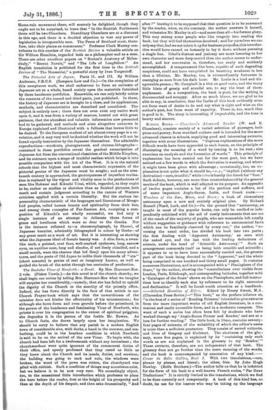The Pictorial Arts of Japan. Parts II. and III. By
William Anderson, F.R.C.S. (Sampson Low and Co.)—On the completion of this sumptuous work, we shall endeavour to form an estimate of Japanese art as a whole, based mainly upon the materials furnished by these handsome portfolios. Meanwhile, we can only briefly notice the contents of the second and third parts, just published. In these, the history of Japanese art is brought to a close, and its applications, methods, and characteristics are described and considered. The subject is entirely new ; there does not even exist any native work upon it, and it was from a variety of sources, hunted out with great patience, that the abundant and valuable information now presented bad to be gathered, and methods and aims altogether unknown in Europe explained and illustrated with a fullness that leaves little to be desired. To the European student of art almost every page is a re- velation, and it may very well be doubted whether the work will not be found equally instructive by the Japanese themselves. The admirable reproductions—woodcuts, photogravures, and cluomo.lithographs- contained in these portfolios reveal the gradual emancipation of Japanese Art from the conventional classicism of the Middle Kingdom, and its entrance upon a stage of truthful realism which brings it into possible comparison with the Art of the West. It is in the natural wheels that the highest and most characteristic expression of the pictorial genius of the Japanese must be sought; and as the nine- teenth century is approached, the grotesqueness of imperfect realisa- tion is replaced by the vigour and vitality seen in the productions of men like Hoknsai and Kikuchi Yosai, which, regarded, as they ought to be, rather as studies or sketches than as finished pictures, both merit and sustain judgment according to the canons of Western criticism applied with a certain liberality. But the carious im- personality characteristic of the languages and literatures of Mongo- loid peoples, veiled human beauty and spirituality from their ken, and among these examples of Far-Eastern Art, excepting a com- position of Kikuchrs not wholly successful, we find only a single instance of an attempt to delineate those forms of grace and loveliness which were so dear to the Greeks. Nor is the instance referred to—a chromoxylograph, by Shansi", of Japanese beauties, admirably lithographed in colour by Grebe—of any great merit as a work of art. But it is interesting as showing what the Japanese ideal of female beauty was. A slim form, a swan- like neck, a pointed, oval face, well-marked eyebrows, long, narrow eyes, an aquiline nose, long and slender, if not finely chiselled, and a small mouth, were the charms that led Genji upon his many adven- tures, and the poets of Old Japan to indite their thousands of " uta " (short sonnets) in praise of real or imaginary Lauras, as well as guided the brush of the artist through ten centuries of production.


































 Previous page
Previous page